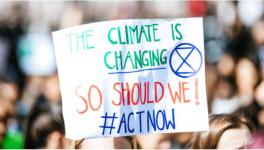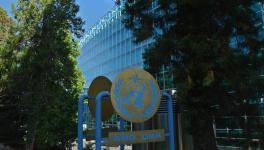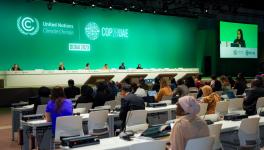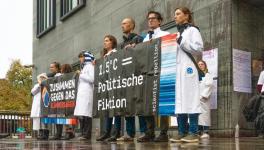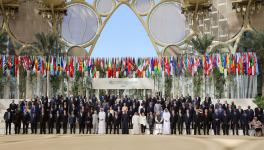Who Pays the Cost for Climate Change?
The debate around responsibility of the North and the South is still hot in the wake of climate change. Sivan Kartha, Stockholm Environment Institute (SEI), talks to Newsclick about sharing of finances and the larger politics involved.
Rough Transcript
Prabir Purkayastha (Prabir): Hello and welcome to the Newsclick. Today, we have us Sivan Kartha from Stockholm Environment Institute who has been working on what is known as Greenhouse Development Rights. Sivan, Good to have you with us.
Sivan Kartha (Sivan): Thank you very much. It's good to be here.
Prabir: Sivan, Climate Change negotiations of course are completely in a deadlock at the moment. We are going to discuss that. Let's discuss what is the core of your work. That how do you see the Global Climate Crisis and what is it that countries have to do that at this the framework that you have built? What is the responsibility of the developed countries?
Sivan: I think the question really itself has to be posed in the context of what the climate system and climate scientists are telling us which is that we really are in a state of emergency. We are at a point where climate has already started to change, damages are already start to be felt climate has already started to change,, impact on development are already very real to many people whether on floods, droughts, impact on food security and given that it means that a dramatic response in necessary. A response that needs fairly radical reductions in the machinery particularly in the north but actually globally and of course that has to be seen in the context of the larger crisis of development that's still around the world. Where the majority of the world is still struggling for basic energy needs. So how do you reconcile those two seemingly irreconcilable demands to do submissions and expand energy services and so sort of passes of thinking that my collaborators and I have gone through is to from the very start think of prudent share in a climate regime in the context of development and think of burden sharing arrangement regime that would acknowledge the majority of the world is still poor in seeking energy services and that would shield that group from the costs of this rapid and the fairly radical transitions. So that was sort of basic how do we allocate costs that shields this group. So the very interesting long term studies about the levels of income that people need to attain before they achieve those basic energy services. So you look through that try and look through that and try and think about who is this group that should be shielded. How larger are they in each country and of course results are helpful in terms of numbers and having analysis. But, they are unsurprising in terms of basic intuition they accord with. There are vast majority of poor people in the south. There's vast majority of middle class consuming class in the north and then there is a minority emerging middle class in the south in India, China and other countries and a group that is sizable in numbers, in terms of absolute numbers may be 80 million, 100 million in India could be called part of consuming class, may be a couple of hundred million in China could be called part of consuming class and a majority of Europe and US.
Prabir: Sivan you look at the studies which talks about one billion emitters. India really figures in one two millions in that sense of emitters who really are causing according to Princeton study.
Sivan: Exactly, it's a few millions depending on what we call high emitters and low emitters it may be higher a small population of the Indian population. They are really high emitters in that sense and similarly for the Chinese population. Let's take that group of people. In India, China US and EU talk about what is their capacity to reduce their emissions and equally what is their responsibility for having contributed to that kind of problem Let's look at those some population, the people who have reason to a certain level of development, they have met their energy needs, they have overcome this classic plagues of poverty like no access to healthcare, no access to education, low life expectancy, high infant mortality. Take this group of people and calculate what is their potential to contribute to solving this problem. You can run through a fairly simple, a fairly straightforward exercise to compare countries on that basis. UN has posed the results that are not too surprising but very helpful in terms of trying to talk in a very specific quantitative way about what each country should be contributing to the problem and if you look as a fraction of total global income above this sort of minimum level of development or total global emissions, to the contribution to the stock above this level of consumption. You see that the US has large fraction despite it's five percent of population of global average, it has one third of the total global capacity and responsibility. The EU has about 25 percent and then China despite it's one fifth of the global population, has about five percent contribution to world's capacity and responsibility. India also being one fifth of the world's population, has you know something like half a percent contribution to stocks and income. So let's think about obligations to the world, obligation to the climate regime, obligation to solving the climate problem in terms of various kinds of allocations of the burden. Third to the US, a quarter to the EU, few percent to China, almost nothing to India and use that as a basis for talk about emission efforts, mitigation efforts.
Prabir: So what you are saying is that the world needs to cut emissions globally at certain rate and if that has to cut at that rate this is the amount of money that is required and that money really is to be built with a fund, a transfer fund if you will, in which each country pays either actually or notionally in terms of the mitigation effort required based on the past emissions it has done, historical emission it has done and it's capability at the moment depending on the income levels either purchasing power parity or in actual terms income levels there. These two are really going to the so called notional funds which you pay for the mechanization. Have I understood them?
Sivan: That's exactly, and I would also put it in notional funds. In many cases mitigation happens to domestically. It needs to be channeled through external fund. In many case, a fund, multilateral fund it's properly managed, and has appropriate governance, would be an appropriate way. In other ways, may be between particular countries. Trading may be a workable way, acceptable way.
Prabir: Leaving out the mechanism of transfer, but as you said the domestic transfers would be basically notional transfers because they take place within the economy. Other transfers are real transfers which you would have to be made in with some mechanism. What is the size of these transfers which we are talking about the cumulative up to 2050 or per year.
Sivan: The estimates of the total cost of very serious programme of climate stabilization, the range, there is a wide range because basically nobody really knows, we have never done before. We know how rapidly how the technology will advance and how quickly the economies will be able to adapt.
Prabir: That's why I said one scenario. Optimistic scenario.
Sivan: The estimates are may be a few percent of the Gross World Product. So let's take the year 2020 when the Gross World Product may be something of near of one trillion dollars. So a few trillion dollars cost per year by 2020. Two trillion, three trillion per year. So a significant fraction of that those costs would be provided by the transfers from North to South. So compare that two trillion dollars to the numbers that are now been politically discussed. The Copenhagen accord and it's sort of formal official adoption through the Cancun agreement suggested that the North would work towards mobilizing 100 billion, 0.1 trillion by 2020. That is a sum that would be allocated to both the adaptation and mitigation. So may be half of that would go towards mitigation. So 0.05 trillion compared to what may be a trillion or more that would actually be needed. We know that for United States for example the tighter emission cuts that are on the table but are politically, seriously being talked about range from a few percents below 1990 level by 2020 to zero percent. Actually to a significant rise above 1990. No effort whatsoever to update that effort. But if you take the kind of approach that we were discussing it were suggesting greater cuts serious cuts clearly. Cuts that are something for mitigation efforts, that is something more or like 60% below 1990 level by 2020 continuing to increase 100% by 2025, 130% by 2030. So, the numbers are much beyond what is politically considered realistic today and actually much beyond what could be undertaken solely through domestic action. Implying some of the action would have to be domestic, the US has to cut emissions but a large factions may be more than half would be undertaken through this type of international mechanism for providing finance and technology to other countries, developing countries that also need to undertake cuts but not necessarily by providing their own finance.
Prabir: Sivan, looking at this numbers, providing political appetite in developed world today, to go anywhere near this figures. How do you think the situation can change. With us really the trillion dollar question that I am missing.
Sivan: How can the situation change? I don't know how it change but I know how precisely it can't change. It would not change if people are talking about what the actual obligation of the North to the world and to the South is. There is such a tremendous willingness to recently accept political reality in the US as an immutable object into accommodate to it.
Prabir: Tea party as a immovable barrier against the climate as the irresistible false.
Sivan: Exactly right. I would put my money on the climate. I think that the tea party would give before the climate gives.
Prabir: Thank you very much. What you are saying is the climate has to take a hand if climate change negotiations has to proceed meaningful.
Sivan: Yes, the worst case scenario that may be the worst case scenario is that we see the climate change rapidly and focus on locus of the power like Washington DC.
Prabir: Large Typhoons and Hurricanes and so on. Unfortunate events as well.
Sivan: Exactly. But preferable is the large Typhoons sitting in Bangladesh
Prabir: That depends if you are in Washington or Bangladesh, unfortunately the powers that would be sitting in Washington. Thank you very much. We will come back to you Sivan as it unfolds to see how it goes.
Sivan: It's my pleasure. Thank you having me.
Get the latest reports & analysis with people's perspective on Protests, movements & deep analytical videos, discussions of the current affairs in your Telegram app. Subscribe to NewsClick's Telegram channel & get Real-Time updates on stories, as they get published on our website.









